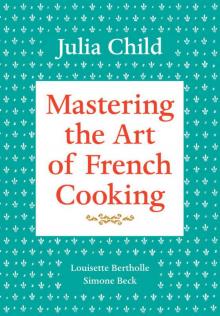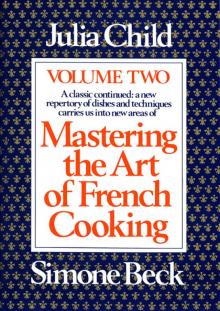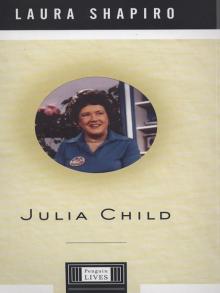- Home
- Julia Child
Mastering the Art of French Cooking, Volume 1 Page 37
Mastering the Art of French Cooking, Volume 1 Read online
Page 37
Sauté de Boeuf à la Provençale
[Beef Sauté with Fresh Tomato Sauce, Olives, and Herbs]
For 6 people
2½ lbs. filet of beef
Cut and sauté the beef as described in the preceding master recipe. Remove to a side dish.
⅓ cup dry white wine or dry white vermouth
2 cups fresh tomato purée with garlic and herbs
⅓ cup pitted black olives, preferably the dryish Mediterranean type
2 Tb mixed fresh green herbs, or parsley
Pour the fat out of the sauté skillet and pour in the wine. Boil it down rapidly until reduced to 2 tablespoons, scraping up coagulated sauté juices. Add the tomato purée and simmer a moment. Then add the sauteed beef and reheat without simmering. Decorate with olives and herbs or parsley, and serve immediately.
LAMB AND MUTTON
Agneau et Mouton
American scientific methods have achieved the miracle of our growing some of the world’s finest wines, and this same approach has worked tremendous improvements in chicken raising, as well as in the cross-breeding, feeding, and raising of lamb. We can now buy large young lamb, 5 to 7 months old, all through the year. From mid-February through April we get lamb grown in the Imperial Valley of California, from May through July it comes from Nevada and Idaho, mountain lamb from Colorado comes to us in the fall, and winter lamb is raised in Ohio and Iowa. Furthermore, over 90 percent of the lamb we see in our big supermarkets has the purple USDA inspection stamps that guarantee a healthy animal, as well as the official grading stamp CHOICE. A whole leg averages 8 to 9 pounds—2 or more pounds over the old average—and makes wonderful eating.
The old labels of spring lamb, milk-fed lamb, and mutton do not apply at all anymore to commercially raised American lamb, but because this is a book of classic French cooking, it is good to know the traditional terminology, and you may still find that these labels apply among private meat purveyors and individual raisers. (Imported lamb from Australia and New Zealand is raised from a smaller breed of animal, and always comes to us frozen.)
TRADITIONAL TERMS FOR LAMB AND MUTTON
Hothouse Lamb, Milk-fed Lamb—Agneau de Lait, Agneau de Pauillac. Very young lamb raised, like veal, on milk, and considered a prime delicacy. Roast it whole with one of the stuffings or cut it up and brown with a mustard coating, like that on the broiled chicken. You may find this in ethnic Greek or Italian markets around Easter time.
Genuine Spring Lamb, Milk-finished Lamb—Agneau Pascal. Lamb that is 3 to 4 months old with delicate, pale red flesh. You’d have to order this from a private breeder or purveyor. Roast, broil, or grill it, stew it en blanquette like veal, or poach it.
Lamb—Agneau. Young lamb, ideally from 5 to 7 months old, the kind we buy today in our large markets. The best French lamb, by the way, has always been considered to be from those fed on the salty grasses of the northern coastal areas, les près salés.
Mutton—Mouton. No longer lamb, from between 12 months and 2 years old, it is mutton. Full-flavored and in need of proper aging, mutton is roasted like lamb, or the chops are broiled, and the rest makes mutton stew. Unfortunately it is rare to find mutton anywhere today, even in France.
LEG OR SHOULDER OF LAMB
Gigot ou Épaule de Pré-salé
PREPARING A LEG OF LAMB FOR COOKING
Trim off all but a thin layer of fat, and remove any loose fat. Shave off the purple inspection stamps.
Leg of Lamb Bone Structure and Cutting Methods
In the following recipes, a 6-pound leg of lamb means the French leg, without the sirloin, since the whole 9-pound leg is more than the average oven wants; however, the whole leg roasts in almost the same amount of time. Although some meat fanciers object to any tampering at all with a leg of lamb, carving is much easier if some of the bones are removed. The tail and the pelvic bone may be cut out, and the meat sewn or skewered together to cover the rump knucklebone. Or if you wish only the shank to remain after the pelvic bone has been removed, the leg bone may be taken from inside the meat without making an outside incision; the meat is then sewn or skewered at the large end. If the leg is boned entirely, then rolled and tied, it makes a compact roast which may be cooked on a spit. Most butchers will perform any of these operations for you, but they are not too difficult to manage by yourself. The bones and trimmings may be turned into a good sauce for your roast, see sauce ragoût.
FLAVORINGS AND STUFFINGS
For a mild garlic flavor, insert 3 or 4 slivers of garlic in the meat at the shank end. For a more pronounced flavor, make several incisions in the meat and insert more garlic slivers. See also the garlic and herb stuffing and other suggestions for boned lamb, and the herbal-mustard coating.
SHOULDER OF LAMB
Shoulder of lamb in America is one half the forequarter of lamb, minus the lower part of the ribs and the shank. It thus forms a square shape, and consists of the upper leg, all or part of the shoulder blade, 3 to 5 shoulder chops, and 2 or 3 vertebrae in the neck. Whole, it weighs 4 to 6 pounds; boned, a third less, or 2½ to 4 pounds. In France the shank is considered to be part of the shoulder, but not the chops. So if you are living there and want to stuff a shoulder of lamb, ask that some of the shoulder chops, côtes découvertes, be included. Otherwise there will be little room for your stuffing. When the shoulder is boned, the fell or top filament, is left intact to form a covering for the roast. After boning, the shoulder may be rolled, tied, and roasted as is. Or it may be stuffed and either rolled and tied into a fat cylindrical shape, or formed into a square cushion roast. Boned shoulder may be substituted for leg of lamb in any of the recipes in this section.
TIMING FOR ROAST LAMB AND MUTTON
Lamb and mutton cooked in the French manner are seared for 15 minutes in a 450-degree oven, then the roasting is continued in a 350-degree oven until the meat is frankly rare, rosy, and juicy. If you prefer lamb well done, do not go over a meat-thermometer reading of 160 degrees or the meat will lose much of its juice and flavor. Medium, from bright to pale pink, would be 140 to 150. A boned leg or shoulder will weigh approximately 30 per cent less than a bone-in piece, but its cooking time per pound usually more than doubles, depending on the thickness of the meat. The estimates in the following list are based on unchilled meat, and the recipes refer to unboned meat unless otherwise specified.
A 6-pound leg or shoulder, bone in
Rare—1 to 1¼ hours (10 to 12 minutes per pound)
Meat Thermometer Reading—125 to 130 degrees
Medium to Well Done—1¼ to 1½ hours (13 to 15 minutes per pound)
Meat Thermometer Reading—145 to 160 degrees
A 4-pound piece of boned and rolled leg or shoulder
Rare—1¾ to 2 hours (25 to 30 minutes per pound)
Meat Thermometer Reading—125 to 130 degrees
Medium to Well Done—2 to 2¼ hours (30 to 35 minutes per pound)
Meat Thermometer Reading—145 to 160 degrees
VEGETABLE SUGGESTIONS FOR ROAST LAMB
Beans
Gigot, haricots—lamb and beans—are a favorite combination. The beans may be plain buttered green beans, or green beans and fresh shell beans (otherwise known as white or cranberry beans), or the dried beans. A mixture of the two is called haricots panachés. Another suggestion is green beans with tomatoes. Additional bean recipes are in the Bean section.
Potatoes
With plain buttered green vegetables you could serve one of the potato casseroles, or the garlic mashed potatoes. Potatoes sautéed in butter, go with either plain or sauced vegetables.
Other vegetables
Rice with mushrooms, could be accompanied by one of the recipes for peas, and baked tomatoes.
Tomatoes stuffed with herbs or mushrooms green beans, and sautéed potatoes are always good with roast lamb.
Eggplant and lamb are an excellent flavor combination. See the eggplant casserole, ratatouille, and the eggplant stuffed with mushrooms on this page.
Brus
sels sprouts or broccoli, or cauliflower, are other ideas. If the vegetables are served plain, you could accompany them with one of the potato casseroles.
TRADITIONAL GARNITURES
Here are some of the traditional French vegetable combinations for garnishing a roast of lamb.
Bruxelloise, braised endive, Brussels sprouts braised in butter, potatoes sautéed in butter.
Châtelaine, quartered artichoke hearts braised in butter, whole baked tomatoes, braised celery, potatoes sautéed in butter.
Clamart, cooked artichoke hearts, filled with buttered peas, potatoes sautéed in butter
Florian, braised lettuce, brown-braised onions, carrots braised in butter, potatoes sautéed in butter
Judic, tomatoes stuffed with herbs or mushrooms, braised lettuce, potatoes sautéed in butter
Provençale, whole baked tomatoes, baked stuffed mushrooms
Viroflay, spinach braised with stock or cream, quartered artichoke hearts braised in butter, potatoes sautéed in butter
WINE SUGGESTIONS
Red wine goes with lamb and mutton. A light red, such as Bordeaux-Médoc, is best with the delicate flavor of young spring lamb. Serve a stronger red, such as Bordeaux-St. Émilion, with more mature lamb. Mutton, or lamb roasted with a strong, herbal stuffing or mustard coating, calls for a sturdier wine, Côtes du Rhône or Burgundy.
GIGOT DE PRÉ-SALÉ RÔTI
[Roast Leg of Lamb]
For 8 to 10 people
Preheat oven to 450 degrees.
A 6-lb. leg of lamb
Prepare the lamb for cooking as described in the preceding paragraphs, and wipe it dry with paper towels.
4 Tb rendered fresh pork or beef fat, or a mixture of melted butter and cooking oil
A roasting pan 1½ inches deep and just large enough to hold the meat
A rack to fit the pan
A bulb baster or long-handled spoon
Brush the lamb with melted fat or butter and oil. Place it on the rack in the roasting pan and set in the upper third of the preheated oven. Turn and baste it every 4 to 5 minutes for 15 to 20 minutes, or until it has browned lightly on all sides. This sears the outside of the meat and prevents its juices from bursting out.
A meat thermometer
1 large carrot, roughly sliced
1 large onion, roughly sliced
Optional: 3 to 6 cloves un-peeled garlic, added to pan ½ hour before end of cooking
Reset oven for 350 degrees. Insert a meat thermometer into the fleshiest part of the lamb. Strew the vegetables in the bottom of the pan. Set lamb in middle level of oven and roast until done. Basting is not necessary.
Total Cooking Time
Rare, 1 to 1¼ hours, 125 to 130 degrees. Meat is slightly resistant when pressed, and if the meat is pricked deeply with a fork, the juices run rosy red.
Medium, 1¼ to 1½ hours, 145 to 150 degrees. Meat is firmer when pressed, juices run a pale rose when meat is pricked.
1 tsp salt
¼ tsp pepper
A hot platter
Discard any trussing strings or skewers. Season the lamb, and place it on a platter. It should rest at room temperature for 20 to 30 minutes before being carved, to let its juices retreat back into the tissues.
1 cup stock, brown lamb stock, or canned beef bouillon
A hot sauceboat
Remove the rack, and spoon the cooking fat out of the pan. Pour in the stock or bouillon and boil rapidly, scraping up coagulated roasting juices and mashing the vegetables into the stock. Taste for seasoning. Just before serving, strain into a hot sauceboat, pressing the juices out of the vegetables. Stir in any juices which may have escaped from the roast.
Water cress or parsley
Hot plates
Decorate the roast with water cress or parsley, and be sure to serve the lamb on hot plates as lamb fat congeals when cold.
VARIATION: OTHER SAUCES
The preceding directions are for a deglazing sauce which furnishes about a spoonful per serving. If you wish more sauce, prepare in advance 2 to 3 cups of sauce ragoût with the lamb bones and trimmings. Omit the stock in the master recipe and stir the sauce into the degreased roasting juices; simmer a moment, and pour into a sauceboat.
Sauce Spéciale à l’Ail pour Gigot
[Garlic Sauce for Roast Lamb]
This very good sauce uses a whole head of garlic which, after two blanch-ings and a long simmering, becomes tamed and develops a delicious flavor.
For 1½ to 2 cups of sauce
1 large head of garlic
A saucepan containing 1 quart of cold water
Separate the garlic cloves. Bring them to the boil in the saucepan and boil 30 seconds. Drain and peel. Set again in cold water, bring to the boil, and drain.
A 1-quart heavy-bottomed saucepan
¾ cup milk, more if needed
⅛ tsp salt
¼ tsp rosemary or thyme
1½ Tb raw white rice
In the saucepan bring the milk, salt, herbs, and rice to the simmer. Add the garlic, and simmer very slowly for 45 minutes, putting in more milk by spoonfuls if the rice is in danger of scorching.
1 cup brown lamb stock, beef stock, or canned beef bouillon
A sieve, a bowl, and a wooden spoon, or an electric blender
Salt and pepper
Pour in the stock or bouillon and simmer 1 minute. Then force through a sieve, or purée in the electric blender. Correct seasoning. Set sauce aside and reheat when needed.
A hot gravy boat
After the lamb has been roasted as described in the master recipe and the roasting pan degreased, deglaze the pan with 2 to 3 tablespoons of stock or water, scraping up coagulated juices. Strain into the hot garlic sauce. Pass the sauce in a hot gravy boat.
VARIATION
Gigot à la Moutarde
[Herbal Mustard Coating for Roast Lamb]
When lamb is brushed with this mixture, garlic slivers and herbal stuffings are not necessary, and the lamb becomes a beautiful brown as it roasts.
For a 6-lb. leg of lamb
½ cup Dijon-type prepared mustard
2 Tb soy sauce
1 clove mashed garlic
1 tsp ground rosemary or thyme
¼ tsp powdered ginger
2 Tb olive oil
Blend the mustard, soy sauce, garlic, herbs, and ginger together in a bowl. Beat in the olive oil by droplets to make a mayonnaise-like cream.
A rubber spatula or brush
Paint the lamb with the mixture and set it on the rack of the roasting pan. The meat will pick up more flavor if it is coated several hours before roasting.
Roast in a 350-degree oven, 1 to 1¼ hours, for medium rare; or 1¼ to 1½ hours for well done. The searing step at the beginning of the master recipe is omitted.
GIGOT OU ÉPAULE DE PRÉ-SALÉ, FARCI
[Stuffed Leg or Shoulder of Lamb]
Boned leg and shoulder of lamb lend themselves nicely to any of the following stuffings, and cold leftovers are particularly good. Lay the boned meat skin side down on a flat surface. Season lightly with salt and pepper. Spread the stuffing over the meat and into the pockets left by the bones. Then roll the meat into a cylindrical shape to enclose the stuffing completely. Sew or skewer if necessary, then tie loops of string around its circumference at 1-inch intervals so the meat will hold its shape. Roast either in the oven or on a spit, or braise it as described. The following are for 3 to 4 pounds of boned meat.
Farce aux Herbes
[Garlic and Herb Stuffing]
½ cup chopped parsley
½ tsp ground rosemary or thyme
2 Tb minced shallots or green onions
½ to 1 clove mashed garlic
¼ tsp powdered ginger
1 tsp salt
¼ tsp pepper
Mix all the ingredients together in a bowl. Spread the mixture on the lamb. Roll and tie as described in the preceding instructions.
Farce de Porc
[Pork and Herb Stuffi
ng]
¾ cup finely minced onions
2 Tb butter
A 3-quart mixing bowl
Cook the onions and butter slowly together in a small saucepan until tender but not browned. Scrape into a mixing bowl.
1 cup fresh white bread crumbs (French or homemade-type bread)
½ cup lukewarm stock or canned beef bouillon
Soak the bread crumbs in stock or bouillon for 5 minutes. Drain in a sieve and press out as much liquid as you can. Save the liquid for your sauce, and place the bread crumbs in the mixing bowl.
½ lb. (1 cup) lean, fresh pork ground with 4 ounces (½ cup) fresh pork fat
1 clove mashed garlic
¼ tsp ground rosemary, sage, or thyme
¼ cup minced parsley
Pinch of allspice
½ tsp salt
¼ tsp pepper
1 egg
A wooden spatula or spoon
Add the rest of the ingredients to the mixing bowl and beat vigorously with a wooden spoon until well mixed. Sauté a teaspoonful until cooked through, and taste for seasoning. Add more seasonings to the stuffing if you feel it necessary.
Spread the stuffing on the lamb. Roll and tie as described at the beginning of this section.

 Julia's Kitchen Wisdom
Julia's Kitchen Wisdom My Life in France
My Life in France Mastering the Art of French Cooking, Volume 1
Mastering the Art of French Cooking, Volume 1 Mastering the Art of French Cooking, Volume 2
Mastering the Art of French Cooking, Volume 2 Laura Shapiro
Laura Shapiro